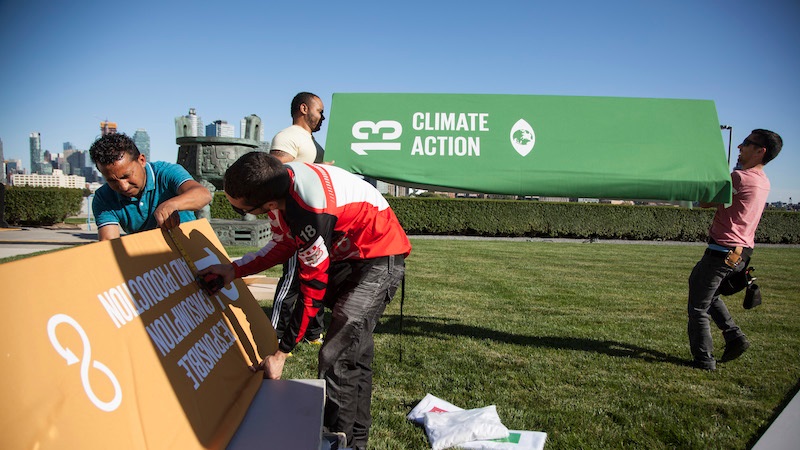
It is generally agreed that climate is a global good. It does not have a border. As a result, when one part of the world causes damage to climate the impact will have consequences on all corners too. This makes the prevention efforts of climate change a globally shared responsibility.
Accordingly under the umbrella of the UN, countries of the world have gathered in Paris in 2015 and sealed an agreement to contribute towards efforts of climate change. This agreement has bound countries with a target namely Nationally Determined Contributions (NDCs).
Accordingly, the global body follows up on how much the countries have progressed so far in implementing their NDCs. Now that COP26, the global summit that focuses on the countries performance of the NDCs, among other issues is closing by, the issue has become a hot agenda.
Nationally determined contributions (NDCs) are at the heart of the Paris Agreement and the achievement of these long-term goals. NDCs embody efforts by each country to reduce national emissions and adapt to the impacts of climate change. The Paris Agreement (Article 4, paragraph 2) requires each Party to prepare, communicate and maintain successive nationally determined contributions (NDCs) that it intends to achieve. Parties shall pursue domestic mitigation measures, to achieve the objectives of such contributions.
The Paris Agreement requests each country to outline and communicate their post-2020 climate actions, known as their NDCs.
According to the Guardian, Those commitments should be made at the two-week Glasgow summit, which begins on 31 October, having been postponed for a year because of Covid-19, to be attended by more than 120 world leaders. In the six years since Paris, scientists have presented a clearer warning of the dangers of allowing temperatures to rise beyond the tougher 1.5C limit, so the declared aim of the UK hosts is to “keep 1.5C alive” by gathering enough NDCs, climate finance and pledges to phase out coal and preserve forests, to make that possible.
Together, these climate actions determine whether the world achieves the long-term goals of the Paris Agreement and to reach global peaking of greenhouse gas (GHG) emissions as soon as possible and to undertake rapid reductions thereafter by best available science, to achieve a balance between anthropogenic emissions by sources and removals by sinks of GHGs in the second half of this century. It is understood that the peaking of emissions will take longer for developing country Parties and that emission reductions are undertaken based on equity, and in the context of sustainable development and efforts to eradicate poverty, which are critical development priorities for many developing countries.
The Paris Agreement recognizes that the long-term goals specified in Articles 2 and 4.1 will be achieved through time and, therefore, builds on a ratcheting up of aggregate and individual ambition over time.
NDCs are submitted every five years to the UNFCCC secretariat. To enhance the ambition over time the Paris Agreement provide that successive NDCs will represent a progression compared to the previous NDC and reflect its highest possible ambition.
China, the world’s biggest emitter, will be key to any hopes of a strong outcome at Cop26, but has yet to submit a new NDC. The president, Xi Jinping, who has not left China since the start of the pandemic, has not said whether he will come to Glasgow, the Guardian reported.
Ethiopia is also at the core of the issue as it has been actively engaged in global environmental protection and climate change prevention efforts. Accordingly, as a party to the agreement, it has submitted its intended NDC and revised it lately by July 2021.
According to the NDC documented which the Environment Forest and Climate Change Commission Submitted to UNFCC, the revised NDC of the country envisages contributing to the global effort through reducing emissions from various sources like land use, livestock, energy, waste, industry, managed soils sectors, among others.
It elaborates that emissions inland use change and forestry originates from the net change in the stock of carbon in the country, largely emanated from land conversion and emissions from biomass energy use. Unlike the first NDC, which only considered forest land as a land category this stock of carbon is determined by the dynamics among all types of land classes namely wetland, forest land, grassland, cropland, settlement and others. The result has shown that land-use change and forestry have the largest mitigation potential as a result of highly ambitious reforestation and forest restoration targets.
The other sector, livestock, exhibits the second most important mitigation abatements. It is also one of the most significant contributors to emission sources contributing to nearly 45 per cent of total base year emissions in 2010 and almost half of the total Business As Usual Assumptions emissions in 2030. Given the economic importance of the sector emission reductions are most visible in improved emission intensities of livestock production.
The energy sector is also said to have huge mitigation potential in the updated NDC next to livestock and land-use change and forestry. The lion’s share of the grid-connected electricity generation comes from renewable sources. Moreover, the contribution from reducing biomass energy emissions has been already accounted for under the land-use change and forestry sector. The energy sector contributes five per cent of the total business as usual emissions in 2030.
The wastewater sector accounts for relevant emission sources with emissions emanating from municipal solid waste generation, decomposition of organic components of waste on landfills, wastewater as well as solid waste incineration. Mitigation action in the waste sector has a significant potential to reduce emissions. The sector contributes three per cent of the total business as usual emissions in 2030. Despite small contributions to the business as usual emission, policy interventions in the sector can be highly effective.
The share of the manufacturing industry has been increasing over the recent past years and the 10 years development plan portrayed that its hare will reach as high as 17.2 per cent of the GDP by 2030. This in turn increases the emission from the sector in the coming years. Cognizant of this, commensurate interventions have been proposed o reduce emissions coming from the sector in the coming years.
BY STAFF REPORTER
THE ETHIOPIAN HERALD OCTOBER 13/2021





